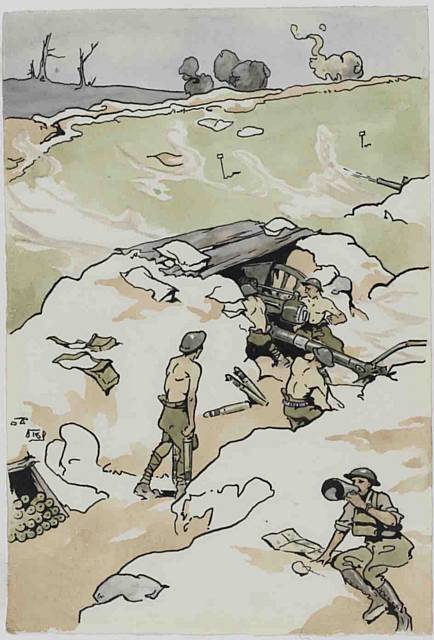Rochdale soldier’s harrowing account of the Battle of Arras is published
Date published: 16 May 2017
One hundred years after the Battle of Arras, on 16 May 2017, the National Army Museum is publishing the drawings and watercolours of Lieutenant Richard Barrett Talbot Kelly, who, as a Forward Observation Officer, had a front row seat of the Arras offensive.
His job was to watch where artillery shells fell and, as a keen artist, he illustrated the battle through watercolours and drawings in a graphic cartoon style.
The initial British attack saw an advance of five miles and the taking of enemy positions with few casualties. It also achieved its strategic objective of drawing German troops away from the Aisne in advance of a French attack. However, success quickly turned to failure when the British found they could not exploit their victory. Talbot Kelly soon realised the army had not planned to support such an advance.
‘We had advanced too far and so quickly that our infantry outposts were now beyond the extreme range of their own field guns, so that we waited expectantly for our cavalry to come up and exploit the complete break in the German defensive system, but they did not come.’
The sudden flurry of snow on the first day of the Battle of Arras had initially helped the British take the enemy by surprise but the freezing weather gave the Germans time to re-organise their defences. The British launched several limited attacks but at a cost.
‘The noise of the German machine guns was completely inaudible and, as I watched, the ranks of highlanders were thinned out and torn apart by an inaudible death that seemed to strike from nowhere.’
For the duration of the battle the Royal Flying Corps flew over enemy lines and battled with a superior German Air Force. They suffered huge losses, losing over four times the number of enemy machines and 400 men. Talbot Kelly noted: ‘the skies were filled with aeroplanes, and for the most part it was generally our own machines that we saw shot out of the sky in flames.’ The life expectancy of a British pilot over Arras was just 17.5 flying hours and the slaughter in the sky became known as ‘Bloody April’.
The British were unable to break through at Arras and by 16 May 1917, the official end of the battle, the Arras front had returned to the day-to-day stalemate of trench warfare.
Emily Charles, Digital Content Producer at the National Army Museum said, 'It’s hard to believe that Talbot Kelly’s drawings of the Battle of Arras are a hundred years old when they’re drawn in such a modern looking cartoon style. His illustrations are a stark and colourful contrast to the grainy black and white photographs and the often-bleak work of war artists that we tend to associate with the First World War.’
Talbot Kelly survived Arras and remained on the front line but was wounded during the preliminary bombardment at the Battle of Passchendaele on 5 August 1917 and was sent home to recover. He remarked that ‘one does not hear the shell that gets one. If the ground had not been a bog and as soft as it was it is absolutely certain that I would have been blown to bits.’
Do you have a story for us?
Let us know by emailing news@rochdaleonline.co.uk
All contact will be treated in confidence.
Most Viewed News Stories
To contact the Rochdale Online news desk, email news@rochdaleonline.co.uk or visit our news submission page.
To get the latest news on your desktop or mobile, follow Rochdale Online on Twitter and Facebook.


